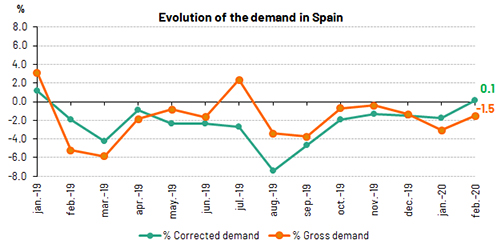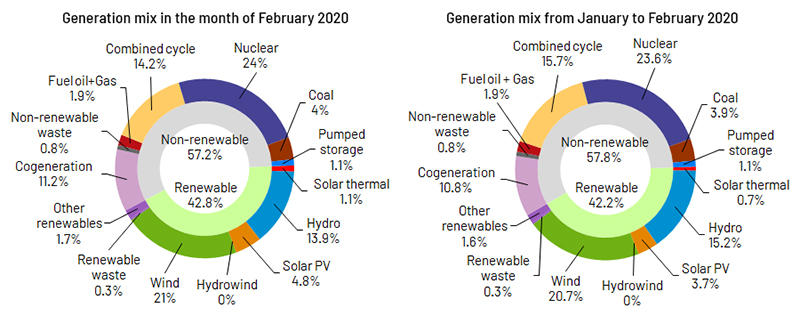For 40 years, we've been driving our country's economic and social progress. Four decades shaping Spain.
Demand for electricity in Spain falls 1.5% in February
- 42.8% of monthly generation came from renewable sources and 67.9% was produced from technologies that do not emit CO2 emissions.
- Compared to February 2019, the demand for electricity in the Balearic Islands fell 2.9% and increased 4% in the Canary Islands.

The demand for electrical energy nationwide in the month of February was estimated at 20,961 GWh, a value that is 1.5% lower than that registered in the same month last year. After having factored in the influence of seasonal and working patterns, the demand for electricity grew 0.1% compared to February 2019.

In the first two months of 2020, demand is estimated at 44,771 GWh, 2.3% less than in 2019. Again, after having factored in the influence of seasonal and working patterns, demand is 0.9% lower than in the same period last year.
In February, according to data estimated at the time of this press release, generation coming from renewable energy sources represented 42.8% of the total production. In the first two months, renewable generation reached 42.2% of the total electricity generated in Spain.
67.9% of electricity generation during the month was obtained using technologies which produce zero CO2 emissions.
With information available as at the time of this press release, wind energy generation in February reached 4,267 GWh, a value 15.5% higher than in the same period last year, and this accounted for 21% of the total production nationwide.

Demand for electrical energy in the peninsular electricity system decreases 1.7%
Demand for electrical energy in the peninsular electricity system in the month of February is estimated at 19,820 GWh, 1.7% lower than that recorded in the same month last year. After having factored in the influence of seasonal and working patterns, the demand for electricity remained unchanged with regard to 2019 figures.
In the first two months of 2020, the demand for electricity on the Spanish peninsula is estimated at 42,383 GWh, 2.5% less than in 2019. Once again, after having factored in the influence of seasonal and working patterns, demand is 1% lower than in the same period last year.
During this month, according to data estimated at the time of this press release, 44.5% of the peninsular generation came from renewable energy sources and 71% was obtained using technologies which produce zero CO2 emissions. Furthermore, wind energy stood at 4,174 GWh, a figure that is 14.4% up on that registered in February last year and contributed 21.6% to the generation mix.
Demand for electricity decreased in the Balearic Islands and increased in the Canary Islands in February
In the Balearic Islands, the demand for electricity in February is estimated at 403,352 MWh, a value that is 2.9% lower than that registered in the same month last year. After having factored in the influence of seasonal and working patterns, the figure decreased by 0.3% with respect to February 2019. In the first two months of 2020, demand in the Balearic Islands is estimated at 859,813 MWh, 3.7% less than in 2019.
Combined cycle, with 78.4% of the total, was the leading source of electricity generation in the Balearic Islands, where renewable technologies and those which produce zero CO2 emissions, accounted for 5.2% of the total generation. For the second month in a row, coal was not used to produce a single MWh in the Balearic Islands system in February.
Regarding the Canary Islands, demand for electricity is estimated at 705,667 MWh, 4% up on that registered in February 2019. After having factored in the influence of seasonal and working patterns, the figure increases by 4.7% with respect to the same month last year. So far in 2020, demand in the Canary Islands is estimated at 1,461,361 MWh, an increase of 1.9% on the same period last year.
During February and according to estimated data, combined cycle was the leading technology in the Canary Islands’ generation mix, with a contribution of 39.5%. Renewables and CO2 free technologies accounted for 16.4% of the generation on the Canary Islands.
Consult our Daily Balance Report for more information on the National, Peninsular, Balearic Islands and Canary Islands electricity systems as at the close of February.












